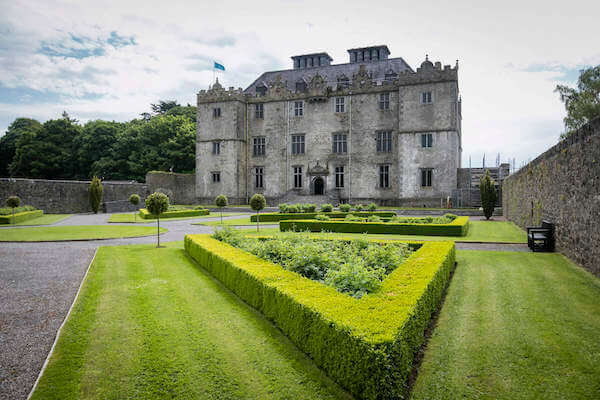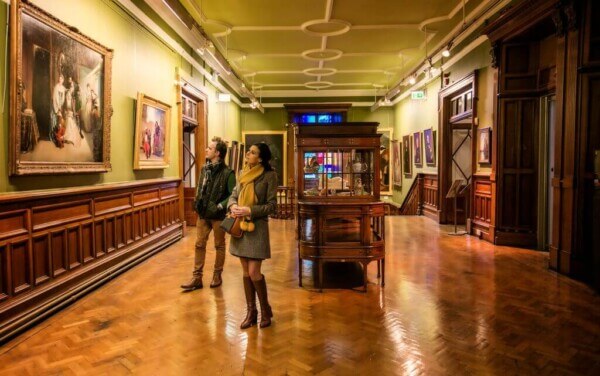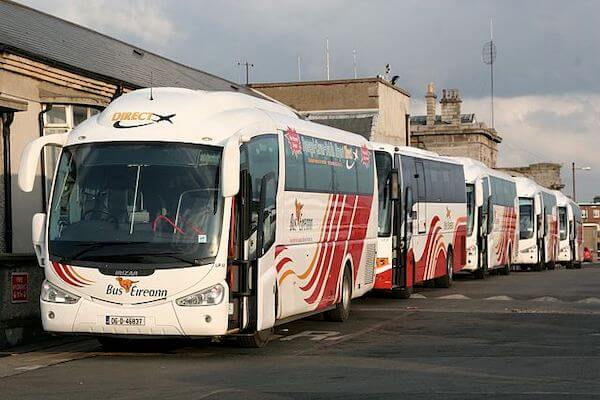Many first-time visitors have little knowledge of how to prepare for a trip to Ireland. But with these 12 tips, I'm hoping you'll feel more confident about planning that dream vacation.
 This post and page contain affiliate links and I may earn compensation when you click on the links at no additional cost to you.
This post and page contain affiliate links and I may earn compensation when you click on the links at no additional cost to you.
1. Use Credit Card Rewards
If you’re wondering what credit cards are the best in terms of travel rewards, my first choice would be the Chase Sapphire Preferred Card, which is also a good credit card to use when renting a car in Ireland.
If you are a member of the Aer Lingus rewards program, AerClub, you can transfer your Chase Ultimate Rewards points directly to the loyalty program at a 1:1 ratio, meaning that 1 Chase Ultimate Rewards point converts to 1 AerClub Avios point.

The Chase cards that are in the Ultimate Rewards Program include the Chase Sapphire Preferred card, the Chase Sapphire Reserve card, the Chase Freedom Flex card and the Chase Freedom Unlimited card, among others.
You could also apply for an Aer Lingus Visa Signature Card.

With the card, you earn 75,000 Avios points after spending $5,000 within three months of opening the account, in addition to 50,000 bonus Avios points when you spend $20,000 within the first 12 months of opening it.
If you are in the American Express Membership Rewards Program, you can also get Avios points on a 1:1 basis.
The American Express Business Gold Card, the Delta SkyMiles Reserve American Express Card, the American Express Green Card, and others are all in this rewards program.
The Marriott Bonvoy program is also a transfer partner, with every 3 points from that program converting to 1 Avios point.
2. Travel in the Off-Season
Traveling to Ireland during the off-season is a lot cheaper than say, the summer months. As you prepare for your trip to Ireland, it's useful to remember that, plus, you’ll also avoid the problem of long lines to attractions and more expensive accommodation.

Instead, try to visit during the “shoulder season,” which is in April, May, early June, and early October.
September, while a bit more expensive, is also a good time to travel to Ireland.
Read More: Best Time to Visit Ireland
3. Find Airfare Bargains
Depending on the time of year that you’re flying, it can be beneficial during the planning process to book a flight that includes a layover. They are usually cheaper.

To do this, you’ll need to use a search engine like Google Flights, Avisales, Priceline or Kiwi, which pulls the prices of flights from thousands of different airlines, going from the most expensive to the cheapest.
Layovers don't suit everyone, however.
In that case, I suggest that you watch out for bargains, including keeping an eye for for sales on Aer Lingus and other airlines that fly direct to Ireland.
4. Use the Right Bank Card

Preparing for a trip to Ireland also means choosing the right bank card, preferably one where you won’t incur foreign transaction fees or ATM usage fees.
I suggest you apply for the Charles Schwab Debit card.
If approved, you’ll get a $100 bonus award on deposits over $1,000. This also applies to other types of accounts that Schwab offers. Even though you will incur some fees while using the card at an ATM in Ireland, all of them will be refunded within a month or so.
5. Purchase a Heritage Card
Most tourists are not aware of this valuable card, which will get you into several heritage sites in Ireland that normally charge an admission fee.
While some heritage sites are indeed free to enter, the card is useful if you intend to visit the fee-paying attractions.

The cost of the card is €40 for adults, €30 for seniors (60 and over), €10 for students and children ages 12-18; and €90 for a family of 7 (kids must be ages 12-18) and is valid for one year from the date of purchase.
You can purchase the card on the Heritage Ireland website or any of the heritage sites around the country.
Take the Treasures of Ireland Tour with TourRadar
6. Accessing WiFi the Smart Way in Ireland
While it’s possible to get Wifi in most public places in Ireland, such as airports, restaurants, and bars, as well as on buses and trains, you won’t be able to access it while you travel around Ireland in your rental car unless you enable data roaming, which can be expensive.

As you prepare for your trip to Ireland, it's know what your Wifi options are. Here are the most common ones.
-
- Sign up for an international mobile usage plan from your carrier but read the fine print before signing on as this can be expensive.
- Purchase a new Sim card for your phone (provided it is not locked) from any Tesco supermarket in Ireland (both north and south of the border), at the WH Smith bookstore in Dublin Airport's Terminal 1 or at the Left Luggage store, also in Terminal 1. You can also purchase a Sim card in Terminal 2 at the Spar shop. Your purchase will also include a mobile usage plan for the duration of your stay in the country.
- Rent a personal WiFi device from Wi-Fi Candy, which can be picked up at Dublin Airport or delivered to your hotel on the first night of your stay. The rates are quite reasonable, and you can get unlimited data usage as well. Get 10% off your purchase with code irelandonabudget.
- Purchase a cheap prepaid phone from Tesco to use while you’re on vacation in Ireland.
- Purchase an eSim from Airalo (this works on an iPhone 11 and up as well as a variety of Samsung phones)
- Simply rely on Wi-Fi when you can, provided you have your data turned off or your phone is on airplane mode.
7. Choose a Smaller Rental Car
If you’re light on luggage, then a compact rental car is something to consider when planning this portion of your trip.

While Ireland’s motorways are equal to those in Europe, the U.S., and elsewhere, there are still many smaller roads that you’ll find yourself navigating.
This is when a small car comes in handy. Gas (petrol) is expensive in Ireland, so renting a smaller vehicle makes sense. If you can drive a stick shift, you can save even more.
8. Avail of Free Museums

As you plan your trip to Ireland, you'll want to take explore all budget options.
In Dublin alone, you’ll find a variety of free museums and galleries to visit.
There are others across the country that are free to visit. Some include the Crawford Art Gallery in Cork; the Museum of Country Life in County Mayo; St. Nicholas' Church in Galway; the Monaghan County Museum, and the Sligo County Museum, as well as the Jackie Clarke Collection in Ballina, County Mayo.
9. Get Fueled Daily with a Hearty Irish Breakfast
Most accommodation in Ireland, whether it’s a B&B or a hotel, will serve a full Irish breakfast that should keep you going for several hours. That's good to know as you plan a road trip across Ireland.

If you must eat during the day, you could pop into a small café and order a bowl of hearty soup and a roll or some delicious Irish cheese and crackers.
Such fare can be easily accessed while on the road at various convenience stores, which are often located within a gas station/petrol stop. Centra and SuperValu are common stores that sell good quality convenience food for travelers on the road.
Find Irish Cheese & Other Irish Favorites at Food Ireland
10. Consider Public Transportation
Getting around Ireland by public transportation is quite doable and often a lot cheaper than renting a car, and is something you should definitely think about as you're planning a vacation to Ireland.

If you’re interested in spending more time in towns and cities, getting there by bus or train is completely doable.

Purchase the above ebook on the Ireland on a Budget Etsy store.
11. Go for Mid-Range Accommodation
My advice when preparing for a trip to Ireland is to choose accommodation that is moderately priced.
Mid-range hotels and B&Bs are always a great option in Ireland. Prices have gone up throughout Ireland post-Covid, and that is especially true in Dublin, Cork, Galway and other big cities.

B&Bs or a family-run hotels tend to be cheaper, and an added advantage of staying in them is that you get to meet the family running the establishment who can give you valuable, on-the-ground advice about local tourist attractions.
If you want to splurge for a night or two, don’t deny yourself that pleasure either.
My suggestions — and those that are popular with members of the Ireland on a Budget Facebook Group — include Ireland's many castle-hotels.
They include Ballyseede Castle Hotel in Tralee, County Kerry; Kinnity Castle Hotel near Birr, County Offaly; Abbeyglen Castle Hotel in Clifden, County Galway, and Ballynahinch Castle Hotel in Connemara, County Galway.
12. Get a Tax Refund on Souvenirs Bought in Ireland
If you are visiting Ireland from outside the EU be prepared to apply for a tax refund on certain items that you buy.

Please know that since VAT has already been added to many goods that are for sale in Irish stores, you will not see that added tax on your receipt, like you will in the United States, for example.
However, some goods, are free from VAT.
They include children’s clothing, footwear, and food (except for chocolate and other confectionery items). If you purchase any of those items, you won’t be able to apply for the special tax refund.

Many stores in Ireland offer VAT-free shopping for tourists outside of the EU. You must ask them first before buying and if you are required to spend a specific amount before you’ll get the benefit.
More information can be found at Ireland's Citizens Information website.
You will not get tax relief on accommodation, car hire, meals, or the cost to visit tourist attractions.
Do you have any of your own Ireland travel planning tips that you can share in the comments below?





